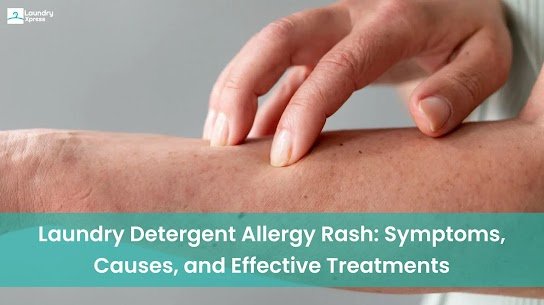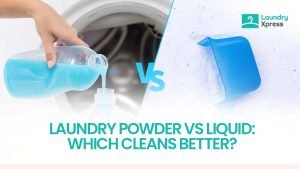Laundry detergent is a must-have household product used to wash clothes and remove stains from them. Unfortunately, for many people, it also causes skin irritation. A rash from laundry detergent allergy is the most frequent problem in cases of sensitive people, as it is the protective barrier of the skin that is affected.
Common Symptoms of a Laundry Detergent Allergy Rash
Skin usually itches and becomes red and inflamed as a result of this kind of allergy, thus making it unbearable. The skin rash can occur either immediately following coming into contact with clothes washed with the offending detergent or it can also appear gradually over time with more exposures. Some people might have only a slight rash whereas others could have more severe symptoms including broken skin or blisters.
Other Signs of Laundry Detergent Allergies
Instead of the common symptoms of itching, rashes due to the use of the inappropriate laundry detergent can result in other indications that are also not very pleasant. Skin dryness and shedding are typical findings that come up when the skin is really doing. These rashes might manifest as small red eruptions or raised areas that resemble hives. In the case with a bad or severe allergy, the swelling can be around the eyes or the mouth.
Understanding the Causes of Laundry Detergent Allergy Rash
Understanding the root causes of a laundry detergent allergy rash is key to finding effective treatments and avoiding future outbreaks. Several chemicals commonly found in detergents can trigger allergic reactions in individuals with sensitive skin.
Fragrances: A Common Trigger
One of the most significant contributors is fragrances. While many people enjoy a freshly-scented laundry load, artificial fragrances used in detergents are often the reason behind allergic rashes. These fragrances are created using synthetic chemicals that can irritate the skin, leading to redness and itching.
Dyes and Their Impact on Skin Sensitivity
Another common cause of allergic reactions in laundry detergents is dyes. Bright-colored detergents often contain artificial dyes to give them a visually appealing hue. However, these dyes can cause skin irritation in people who are sensitive to them.
Preservatives and Their Role in Allergic Reactions
Similarly, preservatives are included in detergents to prolong their shelf life. While preservatives are crucial for preventing bacterial growth and mold, they can also trigger allergic reactions. The most notorious of these preservatives is methylisothiazolinone, which has been linked to allergic reactions in sensitive individuals.
Surfactants: Cleaning Agents That Can Cause Irritation
Additionally, surfactants, which are the cleaning agents in detergents responsible for breaking down stains, can irritate the skin. These chemicals are necessary for cleaning, but they can strip the skin of its natural oils, leading to dryness, itching, and inflammation.
Identifying the Specific Ingredient Causing the Allergy
Many commercial laundry detergents contain a mix of these chemicals, and repeated exposure can result in allergic sensitivity over time. For those who experience allergic reactions, identifying the specific ingredient causing the issue is crucial. Many people are unaware of which ingredient is triggering their symptoms, so it’s helpful to read product labels and opt for detergents that are free of fragrances, dyes, and preservatives when possible.
Immediate Steps for Treating a Laundry Detergent Allergy Rash
It can be quite irritating to have an allergy rash to the laundry detergent, but the remedies are very efficient and can provide a substantial relief to the patients. In case you have got a rash by being exposed to a particular detergent, the immediate measures can help with the severity of the reaction and its symptoms as well as the relief on them.
Conducting the Affected Area Cleaning
The very first thing to do is to clean the affected area thoroughly with lukewarm water and a mild soap to avoid the chemical substances of the rash. Then the problem becomes clear that using hot water should be avoided as it can only exacerbate the rash and increase the pain. Instead of rubbing, try to pat gently the dry area with a soft towel, as not rubbing can further irritate the skin.
Seeking Medical Attention for Severe Reactions
For individuals with more severe rashes or reactions, seeking medical attention may be necessary. A doctor may recommend prescription-strength corticosteroids or other treatments to help manage the symptoms. In cases where the rash doesn’t subside with standard treatments, the doctor may also conduct tests to determine if the allergic reaction is linked to other substances beyond detergent.
Avoid Scratching to Prevent Further Irritation
Another essential tip is to avoid scratching the rash, as this can lead to further irritation or even infection. If the rash worsens or blisters, it’s important to consult a healthcare professional promptly.
Choosing the Right Detergent to Prevent Allergic Reactions
Prevention is key when it comes to managing laundry detergent allergies. The best way to avoid allergic reactions is to choose the right detergent. For individuals with sensitive skin, it’s advisable to select hypoallergenic detergents, which are free from harsh chemicals such as fragrances, dyes, and preservatives. These detergents are specially formulated for people with allergies or skin sensitivities and can help reduce the risk of a rash.
Performing a Patch Test Before Use
When switching to a new detergent, it’s a good idea to perform a patch test. Before using a new detergent on all your laundry, test it on a small section of your skin to see if any allergic reactions occur. Apply a small amount of diluted detergent to an inconspicuous area of skin, such as your wrist, and wait 24 hours to see if any irritation develops. This is a simple way to determine if the detergent is safe for you.
Considering Natural or Plant-Based Detergents
Additionally, for those with very sensitive skin, natural or plant-based detergents might be a good alternative. These products typically contain fewer chemicals and often use organic ingredients, which are less likely to irritate the skin. DIY laundry detergents made from simple, natural ingredients like baking soda, vinegar, and castile soap can also be a safe option for those looking to avoid chemicals entirely.
Ensuring Thorough Rinsing of Clothes
Lastly, washing your clothes thoroughly after using detergent can help minimize exposure to residual chemicals. Consider running an extra rinse cycle to ensure that no detergent residue is left on your clothes. This is especially important if you have sensitive skin, as even trace amounts of detergent can cause irritation.
When to Seek Professional Medical Help
- If the rash persists for more than a few days despite using over-the-counter treatments.
- If the rash worsens or spreads rapidly.
- If the rash causes blisters or severe swelling.
- If the rash is accompanied by symptoms like difficulty breathing, swelling of the throat, or dizziness, seek emergency medical care immediately.
What to Expect from a Dermatologist
- A dermatologist can prescribe stronger medications if needed.
- Allergy testing may be conducted to determine the exact cause of the reaction.
- They can recommend appropriate treatments, including prescription creams, oral antihistamines, or corticosteroids to reduce inflammation.
Having a skin rash caused by a reaction to a laundry detergent is a very annoying thing and it could make many people feel very frustrated; but having the necessary information and giving the best care available can totally ease the irritation and keep the skin healthy and irritation-free. Having the knowledge about the symptoms, knowing the causes, and being aware of the treatment and the preventive measures are essential tips for keeping away the problems that can irritate the skin. If you have sensitive skin, go for hypoallergenic or natural detergents, and, when using new products, make sure to do a patch test.
At Laundry Xpress, we prioritize the comfort and safety of our customers. That’s why we use skin-friendly, hypoallergenic detergents upon request to ensure your clothes are not only clean but also safe for sensitive skin.
FAQs
1- What does a laundry detergent allergy rash look like?
It appears as red, itchy patches, small bumps, or hives, often on areas where clothes touch the skin.
2- How long does a detergent allergy rash last?
Mild rashes clear in a few days; severe ones can last up to a week. See a doctor if it doesn’t improve.
3- What is the best type of laundry detergent for sensitive skin?
Fragrance-free, dye-free, and hypoallergenic detergents are best. Natural, plant-based options are also safer.
4- When should I see a doctor for a laundry detergent rash?
If it lasts more than a few days, spreads, blisters, or you have trouble breathing — seek medical care immediately.





